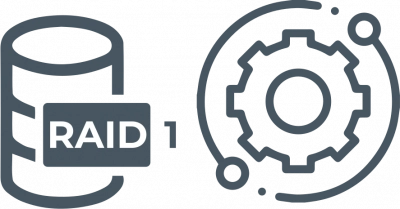RAID 1 Reliability: All What You Wanted to Know
Here you will find out:
- what is RAID 1
- what are RAID 1 reliability
- how DiskInternals can help you
Are you ready? Let's read!
About RAID 1
RAID 1 is a purely mirrored disk array that does not use striping at all. A given raid can consist of at least two disks of the same size, and these two disks are full copies of each other. Mirrored arrays must always be even numbers. Redundancy in a given RAID 1 is repetition for data protection.
At the same time, each disk has a certain capacity. The data is reflected on the other disk, so only the same files can be stored on both disks. This is one of the biggest complaints from users about data storage using mirroring.
RAID 1 provides more or less normal write speed, but faster read speed. The main factor in choosing RAID 1 is maximum reliability: the disk array will work as long as at least one disk in the array is working.
Reliability & Performance of RAID 1
Firstly, RAID 1 is celebrated for its high reliability, primarily due to its mirroring storage mechanism. If one disk fails, you can simply replace it without losing data; just rebuild the array, and you're set.
The dependability of RAID 1 hinges on certain factors, which we'll outline here.
For enhanced reliability, consider using SSDs to construct the array. SSDs have a lower failure rate compared to traditional hard drives.
It's important to note that each RAID setup includes a controller, which can fail just like any other component. In such cases, even the mirroring function may not safeguard your data.
Turning to the performance aspects of RAID 1, it's true that write speeds are not the fastest. However, this is offset by superior read speeds. The overall performance also depends on the type of drives used in the array, with SSDs typically offering better results.
Disadvantages
RAID 1 is not used for huge servers storing terabytes of critical data due to redundancy issues. Because data must be written to mirrored disks both times, the write speed will be slow. As a result, this raid offers half the capacity of the real data storage because half is used for its copies.
In general, RAID 1 is commonly used for backups, however, it does not protect data from power surges or other physical damage. Therefore, if part of the file is damaged, the same damage will be on the other disk.
Note: RAID rebuild time.RAID 1 data recovery with DiskInternals RAID Recovery
DiskInternals RAID Recovery is a specialized application that can perform data recovery at any RAID level, as well as disk imaging.
The program is developed using advanced technologies, considering the wishes of its customers, and a reliable Recovery Wizard will help you if you have little knowledge of how to restore an array. The utility also has additional features for safe data recovery; for example, free preview of files before export, determining important parameters such as disk order, array type, RAID controller type, stripe size, etc.
The program is developed using advanced technologies, considering the wishes of its customers, and a reliable Recovery Wizard will help you if you have little knowledge of how to restore an array. The utility also has additional features for safe data recovery; for example, free preview of files before export, determining important parameters such as disk order, array type, RAID controller type, stripe size, etc.
Follow these instructions for painless array recovery:
1. Download and install DiskInternals RAID Recovery on your computer, then open it and (if necessary) run the Recovery Wizard.
2. Select an array to scan that you want to connect to your computer first.
3. Select the information search mode:
- Fast (superficial),
- Deep (for detailed viewing).
After scanning, view the search results and thus check the integrity and correctness of the data - all these stages are provided to you completely free of charge.
Then purchase a license from the DiskInternals website to complete the export of the data to the desired storage location.

